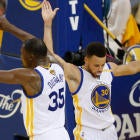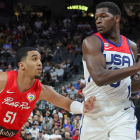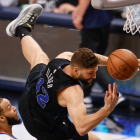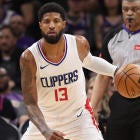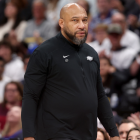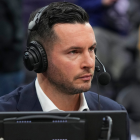After the Golden State Warriors took a 2-0 lead in the NBA Finals against the Cleveland Cavaliers on Sunday, Stephen Curry -- who had a 32-point, 11-assist, 10-rebound triple-double -- felt that he had to be better. In his postgame interview on the court, the Warriors superstar told Doris Burke that he needed to be much more sure with the ball when the series shifts to Cleveland on Wednesday. Curry, after all, had eight of Golden State's 20 turnovers, with six of them coming in the first half.
Obviously, Curry and the Warriors' turnovers didn't matter. Curry was brilliant overall, and his co-star Kevin Durant arguably more so, finishing with 33 points, 13 rebounds, six assists, three steals and five blocks in the 132-113 victory. In the second half, Golden State dismantled the defending champions and made it look easy, like it was a humdrum regular-season game in February.
Even casual observers of the Warriors has seen this script many times before. They started out too sloppy, relying on their superior shot-making, and led by only three points at halftime. When they started to value the ball and make fewer mistakes, they separated themselves. This happened even though coach Steve Kerr had been urging them to build on what they did in the series opener, in which they turned the ball over just four times.
"The focus the last two days [was], 'Can we repeat the formula?' Kerr said. "The answer was no. We did not repeat it. Tonight was a game based on talent. We had a lot of guys who played exceptionally well individually and we played with great energy."
Kerr then echoed his point guard: "Heading to Cleveland, we're going to have to be a lot smarter. We play that same game in Cleveland, there's no way we win."
That is certainly one way to look at it. If you are not in Golden State's locker room, though, you might see it differently. The talent Kerr talked about is significantly greater than the Cavaliers', so the Warriors have plenty of room for error. It is scary how lopsided this could look if the Warriors executed to the best of their ability for a full game.
"We were much more physical today than we was in Game 1, and we forced 'em into 20 turnovers," LeBron James said at his locker, laughing a little bit, "and they still beat us pretty good."
James, by the way, had a triple-double himself -- 29 points, 14 assists and 11 rebounds -- but he had to expend more energy to get his points, largely bullying his way to the basket. The contrast between the way these teams have scored in these two games has been just as striking as the 22-point and 19-point differentials. Curry made one insane move against James, but that type of one-on-one play was the exception rather than the norm for Golden State. While the Warriors' ball movement and spacing make the game look simple for their stars, Cleveland relies on its stars' individual wizardry to make the magic happen. Some examples:
In the second quarter, Kyrie Irving isolated against Curry, went away from the help defense and made a floater with the shot clock running down:
On the next possession, Curry and Draymond Green ran a simple pick-and-roll and Green found Shaun Livingston for an alley-oop:
In the fourth quarter, Irving showed why he might be the best ballhandler on the planet, then beat Ian Clark off the dribble and finished around David West:
On the next possession, with the Cavs worrying about all of the Warriors' screens and cuts, Durant swished a long catch-and-shoot jumper over James, the kind of shot that is only possible when you're a 7-foot sharpshooter:
Right after that, Irving ran a pick-and-roll to get Clark on him, then went ISO again, making a ridiculous stepback 3-pointer:
Golden State then answered with a Klay Thompson 3-pointer, but this one was wide open after a pick-and-roll with Durant:
This is part of the reason playing for the Warriors appealed to Durant in the first place. He and Curry can make absurd, amazing shots, but they usually don't have to. They play for a team that manufactures good looks better than perhaps any in NBA history. In order to upset them, Cleveland has to be just about perfect on both ends -- if it misses or turns the ball over; Golden State will try to push the ball every time; if it miscommunicates defensively, the Warriors will almost always capitalize.
On Thursday, I argued that the Cavs had to slow the pace. There are several tactical reasons for this, but there's also an extremely basic one: The more possessions there are, the more chances Golden State has to build a lead. Beyond the fact that Cleveland needs to get the Warriors out of their rhythm, less talented teams should generally want games to be ugly. The way this is going, the Cavs could very well look like the harder-playing team, but that won't necessarily get them anywhere.













